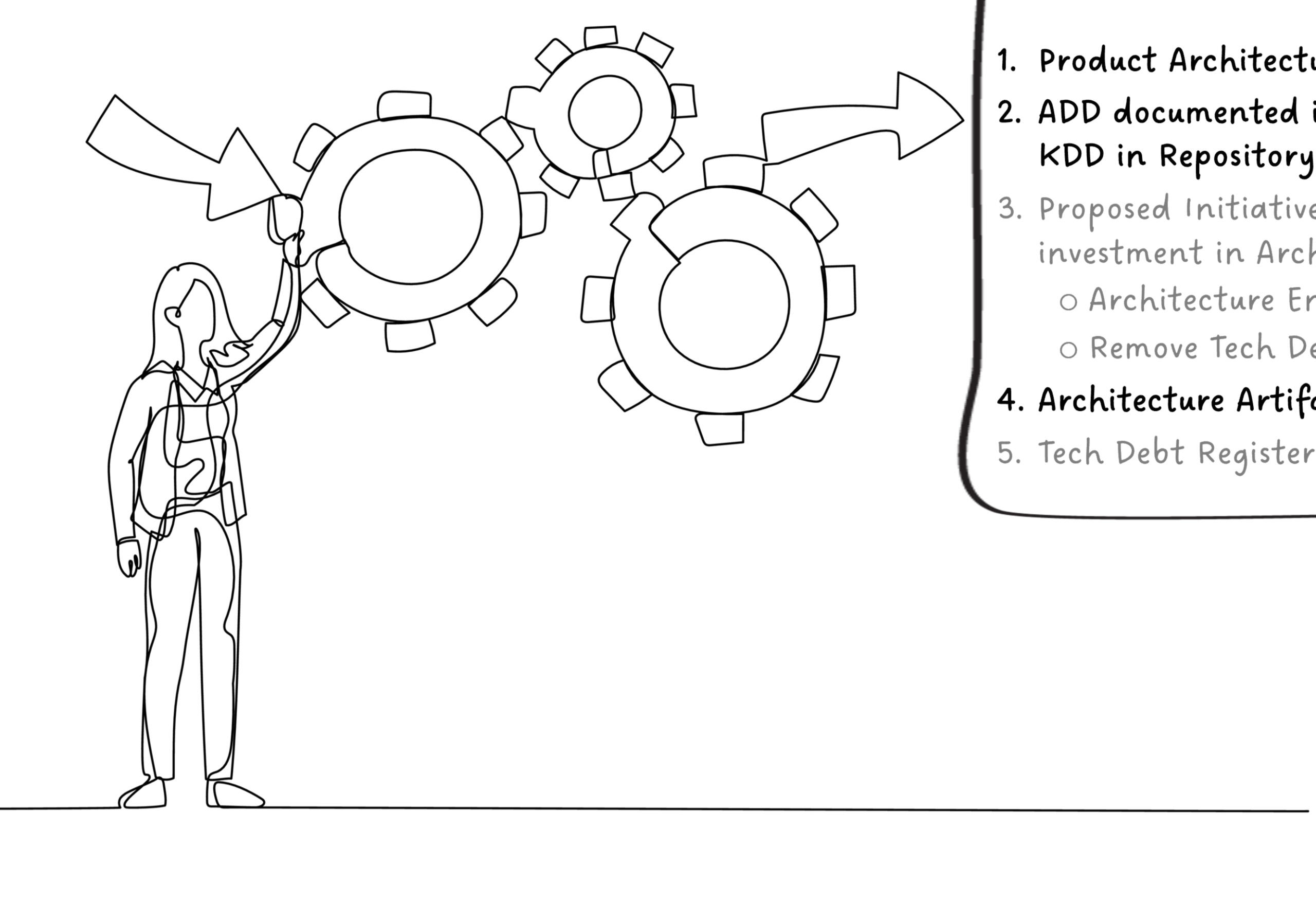Typical Engagements

Capability Maturity Assessment
Perform diagnostic to gain insights on gap between current performance and stakeholders' expectations
Identify areas where interventions are most needed to optimise improvement efforts
Lead transformation from current to desired target maturity level
Learning Needs Analysis
Identify development needs and relative priorities
Assess whether existing training offer aligns with business goals
Engage with key stakeholders to identify appropriate learning options for architects and other professionals
Review existing content that may be enhanced and reused


Team and individual upskilling
Design career pathways and comprehensive development programs for small and large teams
Customise and lead training courses / workshops to develop solution & enterprise architecting skills
Coach & mentor principal / chief architect
TOGAF® Accredited Trainer
iSAQB® Accredited Training Provider (CPSA-F)
Rewire Architecting
Define clear structure, roles, and responsibilities; optimise operating model for business / IT alignment
Establish Decision-centric Architecting, from investment planning, to roadmaps, to solution design
Adopt pragmatic frameworks tailored to your needs and current maturity level
Establish adaptive governance & risk management, embedded in broader decision making
Agile Architecting Playbook
Toolbox: selection, implementation, adoption


EA Capability Boost
Augment your EA team with deep expertise and renewed energy
Refresh architecture principles, policies, standards, guardrails, and templates
Define multi-year business capability roadmaps to drive investment portfolios
Assessment of the IT landscape and drive its optimization through modernisation and rationalisation of application and technology portfolios
Create ad-hoc C-level insights and visualisation to communicate architecture and its value
Architecture Reviews
What is Architectural Thinking?
Architectural thinking requires navigating and making trade-offs decisions across several (3+) dimensions. For example, thinking architecturally about a new building should probably consider at a minimum the dimensions of landscape, space, time, and people. For digital enterprises, business needs, cost, resilience, security, and usability are typically important architectural dimensions.
Why me?
I care passionately about making a difference rather than just showing upI have a proven track record helping global and complex firms addressing these challengesWith a genuine passion for the topic, I bring enthusiasm and high-energyNot a one-size-fit-all approach: I bring a lot of experience and templates, but solely with the purpose of tailoring to your specific needsI 'speak business', and can articulate business value of architecture and architecting to business executives and IT leadersI am not afraid to challenge: not just an order taker, I do not avoid a difficult discussion when is needed to drive improvementsI am independent, and do not have any bias towards any architecture framework, tool, or vendor, so I can give unbiased adviseI want to be part of a welcoming, inclusive culture, guided by leaders with integrity who care about people and support them to develop as individuals and professionals
To learn more about my training or consulting services, or to schedule a meeting to explore a possible collaboration, please send me a message.
Thank You
Architetural Thinking Blog
Architecture as a Business Capability (October 2012)
I think of IT Architecture Capability as the combination of people (their competencies and skills, regardless of their team names or job titles), methods, information and supporting tools that allows an organization to consistently produce IT products with a fit-for-purpose architecture, cost effectively.I believe that Architecting IT solutions that are fit for purpose is an important business capability in many enterprises. Not strategic, in most cases, but definitively important. It needs to be done well, and it needs to be done cost effectively.Being a business capability, I would argue that the architecture practice of an IT organisation should be run like a business, competing with other business capabilities (marketing, operations, sales, etc) for organisational resources to generate value that exceeds the cost of capital. As such, traditional technical competencies are necessary but insufficient to be successful. An organisation designing the best cars in the works, will fail without supporting competencies in marketing, production, performance measurement, supplier management, quality, and many other disciplines.Ultimately, to be successful, an architecture practice needs to provide to its stakeholders (within and outside IT) what they need, cost effectively. Worth repeating: to be successful, your architecture practice needs to provide to your stakeholders what they need at a reasonable cost.
Not deliverables, but architecture consumables (November 2012)
Let’s face it: IT architects produce a lot of what I would call “architectural waste”. Too often, the focus is on architecture deliverables. We deliver them, and then we start working on the next deliverable.Unfortunately, architecture deliverables that remain “unconsumed” are not generating value: yes, it’s architectural waste! Think of the IT Value chain: what we produce should be consumed by the next step in the value chain to ultimately generate value to the firm. Another useful metaphor is that of intangible assets in a balance sheet: an architectural asset is such only if has a value and can be turned into cash! If the cost of acquiring the asset is greater than the actual value, you will need to write off at some point in the future.A roadmap that remains on a powerpoint slide, a solution architecture ignored by the project delivery team, a too abstract corporate data model, an unrealistic target application architecture, a forgotten architecture vision: these are all examples of architectural waste. To avoid this, we need to make sure that they are considered as assets and therefore consumed by the next step in the value chains, and eventually become value delivered to the firm.We should stop thinking in terms of architecture deliverables, and start thinking in terms of architecture consumables. Here are a few tips on how to do that:
Make it clear what type of work products you are planning to produce; there is only a few possible of types: 1) a strategy or position paper; 2) a plan or roadmap; 3) a (current or target) model; 4) a gap analysis; 5) a technology evaluation paper; 6) a policy or standard; 7) a service definition; 8) a service or application.
Granted: this is not a complete list, but you get the idea…. A good architecture practice will produce a healthy mix of those consumables.
Make it clear how your consumable fits in the overall IT value chain. In other words, be explicit on who your consumer/customer is (within IT or business). Simple rule: no customer, no value!
Think and communicate what the purpose of the work product is; why will be be useful to those consuming it, in other words, what’s the value proposition.
Be explicit on the planned completion date. Be realistic and explicit (too many architectural efforts go on, and on, and on…)
Communicate the dependencies (in other words describe what’s the previous step in the value chain), but expect to be challenged. There will always be dependencies, but you have to make a call on whether you enough data to proceed with your work or not.
Define the success measures. A very important measure is probably your consumers/stakeholders’ satisfaction, but you should be able to have other measures too. For example, for a plan or roadmap securing the funds for its execution is a good success criteria. For a standard, its degree of adoption (anyone can define a standard that nobody follows…).
No more deliverables, but architecture consumables….
Architecting Capability and Architectural Significance (July 2013)
Building and maintaining a mature architecting capability is not cheap, especially in large global organisations. Typically, with a program/project portfolio in the hundreds, it is impossible to assign good architects to cover the entire portfolio.Even merely trying to achieve an effective architecture governance, well integrated with the broader IT governance processes, is in itself challenging and often impossible for a portfolio of that size!Relatively to many other IT areas, architecting is an expensive activity, and investing in it must make business sense. Just like architecting in the construction’s industry, you wouldn’t hire a top architecture firm to extend your kitchen or build a standard block of flats; not only you would struggle to hire and retain a top architect and make the most of her expertise, but also the cost of a top firm would not be justifiable for such projects.Allocating the best architects where it is most needed happens ad-hoc in small IT shops, but with portfolios in the region of several hundreds IT programs, and a typically resource-constrained architecting practice, in large organisations the work of highly skilled architects must be prioritised systematically.This can be achieved by introducing the concept of “architectural significance”, and classifying the entire portfolio accordingly. Typical values of architectural significance are High, Medium, Low and Unknown. As a rule of thumb, less than 5% of your portfolio should be of Unknown Architectural Significance (UAS) at any time, and publishing monthly metrics on the architectural significance of your portfolio is a good incentive to minimise the “unknown” and build a good understanding on the architectural relevance of the program portfolio.Once you understand where the architectural need is greatest, a more optimal resource allocation is possible. For programs of High Architectural Significance (HAS) it makes sense to assign good architects from early on to collaborate with the program on a continuous basis, often with the responsibility of leading the architecture and design work. For programs of Medium Architectural Significance (MAS), a one-off architecture review is normally sufficient, whilst no architecture engagement is typically required for programs of Low Architectural Significance (LAS).To make this work, an effective collaboration with portfolio/program/project managers is required, and these are some good practices to encourage that:
don’t capture architecture significance on an isolated spreadsheet; much better to extend the data model of the portfolio management system to capture architectural significance and other architecture engagement attributes (Lead Architect, Lead Reviewer, architecture milestones, etc.)
involve the portfolio and the program manager when deciding whether a certain program is of high architectural significance
publish criteria to help decide the degree of architectural significance; budgeted expenditure is one of many criteria, others should be alignment with target architecture, impact on strategic systems, etc.
produce a short e-learning module and other artefacts (architecture engagement in 1-page) targeted for that specific audience
I have introduced architectural significance as a way to modulate architecture engagement twice now, and I know it works.
Minimum Enterprise Requirements (September 2014)
Believe it or not, many people in IT and business are still struggling with the concept of Enterprise Architecture, and the actual value it provides to the organisation. The theory is clear, less so how it translates into real value in practice.The need for well articulated and clear Requirements, however, is well understood. And people generally understand that designing and implementing IT Systems to satisfy requirements generates value to the firm.Rather than EA and Architecture Standards, I prefer to talk about Minimum Enterprise Requirements (MERs).Enterprise Requirements are requirements that exist beyond the boundary of a project or program. They are Minimum when satisfying them is not discretionary. Typically, requirements deriving from a security policy, regulatory demands or strict business constraints are good candidates for MERs.A MER is a requirement coupled with a clear applicability trigger criteria. This is important, because designing and implementing MERs can (and normally is) expensive. Whether a MER applies to a specific IT System needs to make business sense. Implementing Security MERs to provide a very high level of assurance, for example, makes only sense if the IT System stores/processes/displays data that is classified as strictly confidential.I often use the example of Building Regulations to explain MERs and triggers.MERBuilding regulations contain the rules for building work in new and altered buildings to make them safe and accessible and limit waste and environmental damage. People carrying out building work must usually arrange for their work to be checked by an independent third party to make sure that their work meets the required standards. In some cases the installer can certify themselves that their work complies (https://www.gov.uk/government/policies/providing-effective-building-regulations-so-that-new-and-altered-buildings-are-safe-accessible-and-efficient). In other words, if you’re building a hospital, there is a MER for disabled access. It’s applicable to all hospitals, and is not discretionary!To evaluate whether a MER is a good MER I have devised a TUSIV test. As such, MERs must be:
Traceable (to a business approved firm policy, standard or directive)
Unambiguous
Singular
Implementable
Verifiable
What is Architectural Thinking (March 2015)
Thinking becomes architectural thinking when at least two criteria are met:
Architectural thinking is thinking with a purpose. Thinking how to best articulate a complex issue, solve a problem, make a difficult decision, tell an intricate story; these are all examples of thinking with a purpose
Architectural thinking requires navigating and making trade-offs decisions across at least 3 different dimensions. For example thinking architecturally about a new building should probably consider at least the dimensions of space, time and people (the architect that doesn’t think about the people using the building is unlikely to succeed). Business needs, cost, resilience, security, and usability are some important dimensions (there are also others) for developing IT systems.
Trainingbrite LTD customer privacy notice.This privacy notice tells you what to expect us to do with your personal information.
- Contact details
- What information we collect, use, and why
- Lawful bases and data protection rights
- Where we get personal information from
- How long we keep information
- How to complain
Contact details
Email: [email protected]What information we collect, use, and why
We collect or use the following personal information for information updates or marketing purposes:Names and contact details
We collect or use the following personal information for dealing with queries, complaints or claims:Names and contact details
Lawful bases and data protection rights
Under UK data protection law, we must have a “lawful basis” for collecting and using your personal information. There is a list of possible lawful bases in the UK GDPR. You can find out more about lawful bases on the ICO’s website.Which lawful basis we rely on may affect your data protection rights which are set out in brief below. You can find out more about your data protection rights and the exemptions which may apply on the ICO’s website:Your right of access - You have the right to ask us for copies of your personal information. You can request other information such as details about where we get personal information from and who we share personal information with. There are some exemptions which means you may not receive all the information you ask for. Read more about the right of access.
Your right to rectification - You have the right to ask us to correct or delete personal information you think is inaccurate or incomplete. Read more about the right to rectification.
Your right to erasure - You have the right to ask us to delete your personal information. Read more about the right to erasure.
Your right to restriction of processing - You have the right to ask us to limit how we can use your personal information. Read more about the right to restriction of processing.
Your right to object to processing - You have the right to object to the processing of your personal data. Read more about the right to object to processing.
Your right to data portability - You have the right to ask that we transfer the personal information you gave us to another organisation, or to you. Read more about the right to data portability.
Your right to withdraw consent – When we use consent as our lawful basis you have the right to withdraw your consent at any time. Read more about the right to withdraw consent.
If you make a request, we must respond to you without undue delay and in any event within one month.To make a data protection rights request, please contact us using the contact details at the top of this privacy notice.Our lawful bases for the collection and use of your data
Our lawful bases for collecting or using personal information for information updates or marketing purposes are:Consent - we have permission from you after we gave you all the relevant information. All of your data protection rights may apply, except the right to object. To be clear, you do have the right to withdraw your consent at any time.
Our lawful bases for collecting or using personal information for dealing with queries, complaints or claims are:Consent - we have permission from you after we gave you all the relevant information. All of your data protection rights may apply, except the right to object. To be clear, you do have the right to withdraw your consent at any time.Where we get personal information from
- Directly from youHow long we keep information
- Until you notify us otherwiseFor more information, see our guidance on how long you should store information (opens in a new window).]How to complain
If you have any concerns about our use of your personal data, you can make a complaint to us using the contact details at the top of this privacy notice.If you remain unhappy with how we’ve used your data after raising a complaint with us, you can also complain to the ICO.The ICO’s address:Information Commissioner’s Office
Wycliffe House
Water Lane
Wilmslow
Cheshire
SK9 5AFHelpline number: 0303 123 1113Website: https://www.ico.org.uk/make-a-complaint

Architectural thinking requires navigating and making trade-offs decisions across several (3+) dimensions. For example, thinking architecturally about a new building should probably consider at a minimum the dimensions of landscape, space, time, and people. For digital enterprises, business needs, cost, resilience, security, and usability are typically important architectural dimensions.




